A Study on Environmental Management of Tourism: Research Proposal
VerifiedAdded on 2020/06/03
|10
|3205
|60
Report
AI Summary
This research proposal investigates the critical role of environmental management within the tourism industry, using the Thomson Group as a case study. The study aims to assess the need for environmental management, identify existing sustainable practices, and determine the roles of stakeholders in achieving effective environmental management. The research explores the negative impacts of tourism on the environment, emphasizing the need for sustainable development to protect natural resources for future generations. The proposal outlines the research questions, literature review, and research methodology, including a descriptive research design and an interpretivism research philosophy. The study intends to provide recommendations for the Thomson Group to improve its environmental practices and contribute to the sustainable development of the tourism sector. The research highlights the responsibilities of various stakeholders, including tourism organizations, regional governments, and visitors, in ensuring environmental protection. The proposal suggests strategies for reducing environmental impact and promoting sustainable tourism practices, such as water conservation, waste management, and reducing carbon emissions. The research emphasizes the importance of environmental management for long-term sustainability and the preservation of heritage sites.
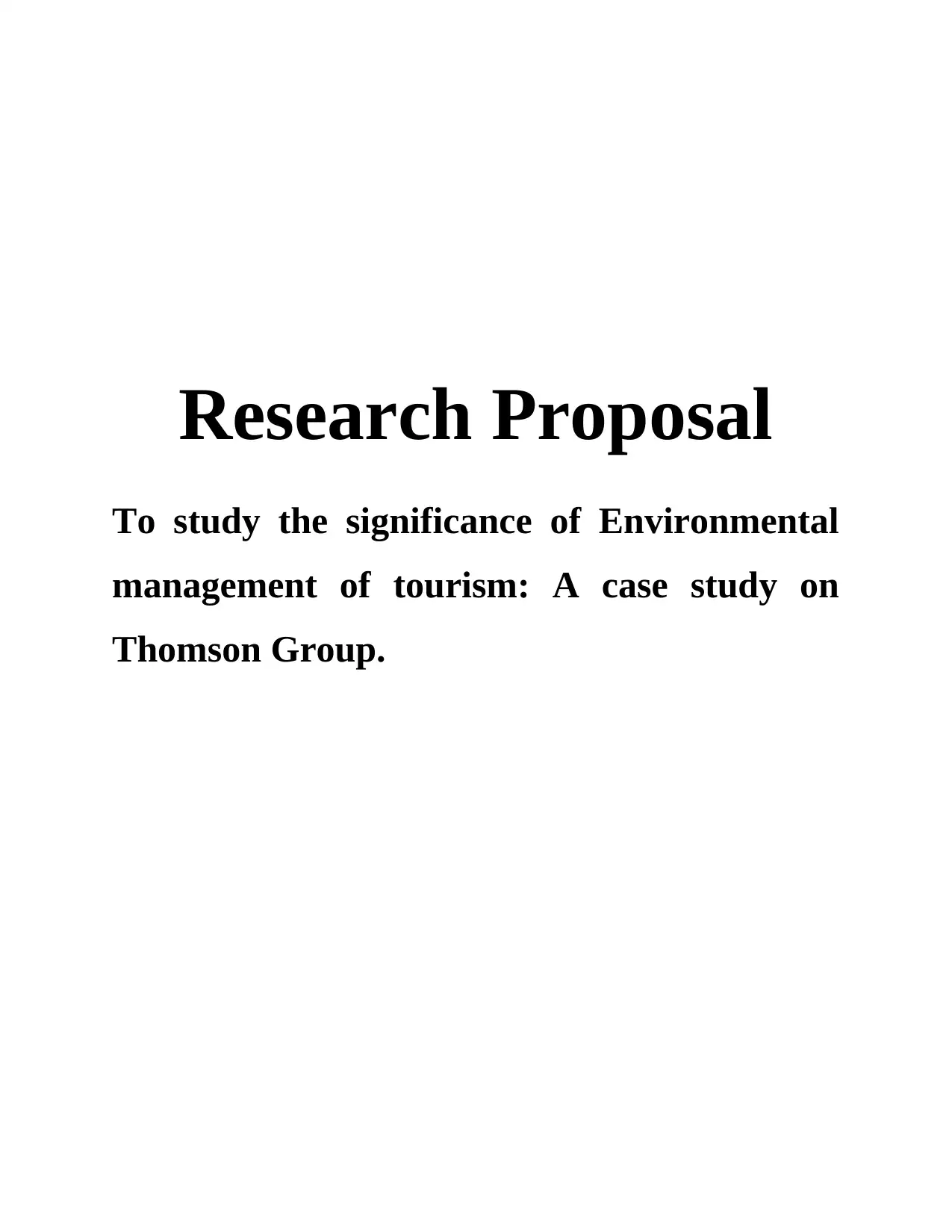
Research Proposal
To study the significance of Environmental
management of tourism: A case study on
Thomson Group.
To study the significance of Environmental
management of tourism: A case study on
Thomson Group.
Paraphrase This Document
Need a fresh take? Get an instant paraphrase of this document with our AI Paraphraser

TABLE OF CONTENTS
INTRODUCTION...........................................................................................................................3
Problem Statement......................................................................................................................3
Aims and Objectives...................................................................................................................4
Research Questions.....................................................................................................................4
Literature review.........................................................................................................................5
Research Design and Methodology............................................................................................7
Time-scale...................................................................................................................................8
Resources....................................................................................................................................9
REFERENCES..............................................................................................................................10
INTRODUCTION...........................................................................................................................3
Problem Statement......................................................................................................................3
Aims and Objectives...................................................................................................................4
Research Questions.....................................................................................................................4
Literature review.........................................................................................................................5
Research Design and Methodology............................................................................................7
Time-scale...................................................................................................................................8
Resources....................................................................................................................................9
REFERENCES..............................................................................................................................10
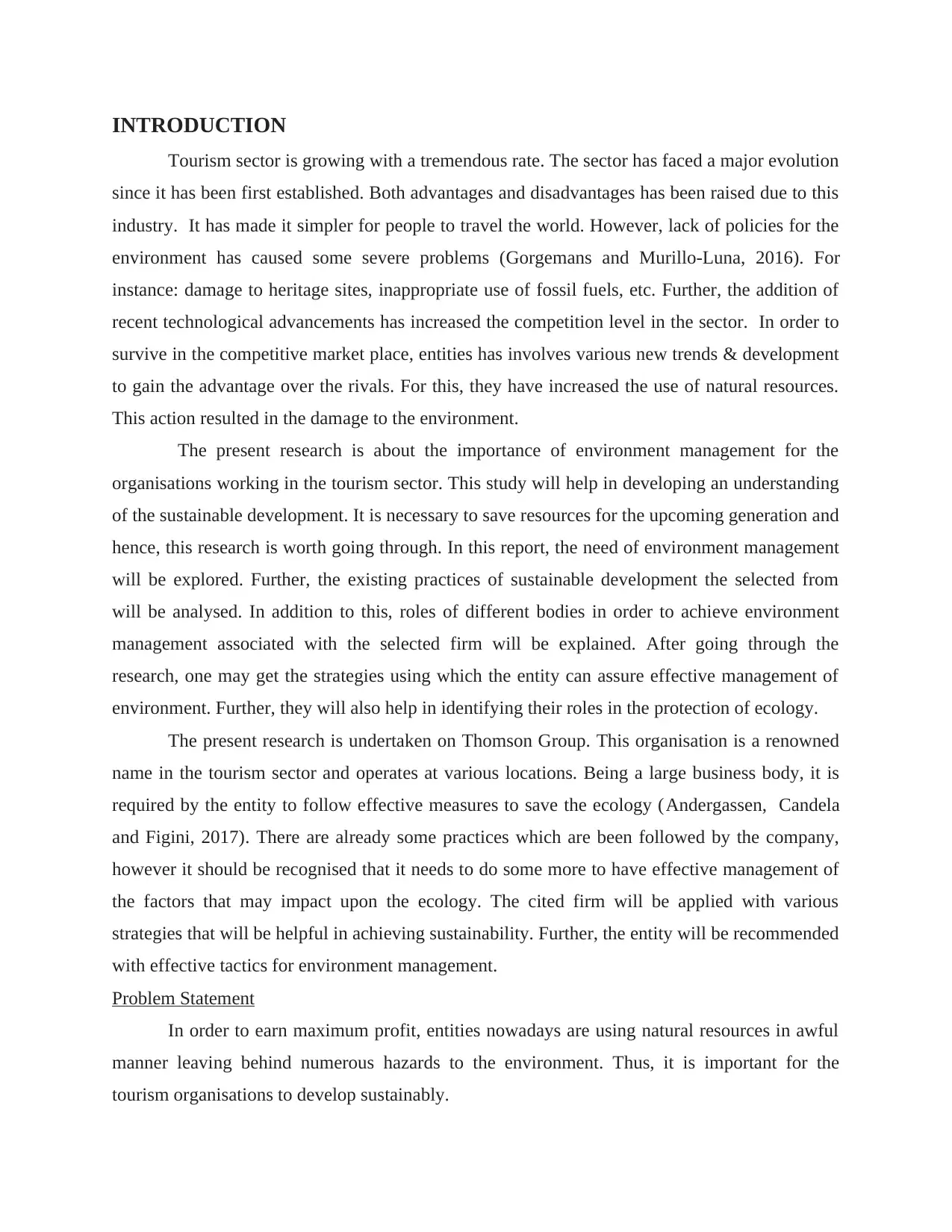
INTRODUCTION
Tourism sector is growing with a tremendous rate. The sector has faced a major evolution
since it has been first established. Both advantages and disadvantages has been raised due to this
industry. It has made it simpler for people to travel the world. However, lack of policies for the
environment has caused some severe problems (Gorgemans and Murillo-Luna, 2016). For
instance: damage to heritage sites, inappropriate use of fossil fuels, etc. Further, the addition of
recent technological advancements has increased the competition level in the sector. In order to
survive in the competitive market place, entities has involves various new trends & development
to gain the advantage over the rivals. For this, they have increased the use of natural resources.
This action resulted in the damage to the environment.
The present research is about the importance of environment management for the
organisations working in the tourism sector. This study will help in developing an understanding
of the sustainable development. It is necessary to save resources for the upcoming generation and
hence, this research is worth going through. In this report, the need of environment management
will be explored. Further, the existing practices of sustainable development the selected from
will be analysed. In addition to this, roles of different bodies in order to achieve environment
management associated with the selected firm will be explained. After going through the
research, one may get the strategies using which the entity can assure effective management of
environment. Further, they will also help in identifying their roles in the protection of ecology.
The present research is undertaken on Thomson Group. This organisation is a renowned
name in the tourism sector and operates at various locations. Being a large business body, it is
required by the entity to follow effective measures to save the ecology (Andergassen, Candela
and Figini, 2017). There are already some practices which are been followed by the company,
however it should be recognised that it needs to do some more to have effective management of
the factors that may impact upon the ecology. The cited firm will be applied with various
strategies that will be helpful in achieving sustainability. Further, the entity will be recommended
with effective tactics for environment management.
Problem Statement
In order to earn maximum profit, entities nowadays are using natural resources in awful
manner leaving behind numerous hazards to the environment. Thus, it is important for the
tourism organisations to develop sustainably.
Tourism sector is growing with a tremendous rate. The sector has faced a major evolution
since it has been first established. Both advantages and disadvantages has been raised due to this
industry. It has made it simpler for people to travel the world. However, lack of policies for the
environment has caused some severe problems (Gorgemans and Murillo-Luna, 2016). For
instance: damage to heritage sites, inappropriate use of fossil fuels, etc. Further, the addition of
recent technological advancements has increased the competition level in the sector. In order to
survive in the competitive market place, entities has involves various new trends & development
to gain the advantage over the rivals. For this, they have increased the use of natural resources.
This action resulted in the damage to the environment.
The present research is about the importance of environment management for the
organisations working in the tourism sector. This study will help in developing an understanding
of the sustainable development. It is necessary to save resources for the upcoming generation and
hence, this research is worth going through. In this report, the need of environment management
will be explored. Further, the existing practices of sustainable development the selected from
will be analysed. In addition to this, roles of different bodies in order to achieve environment
management associated with the selected firm will be explained. After going through the
research, one may get the strategies using which the entity can assure effective management of
environment. Further, they will also help in identifying their roles in the protection of ecology.
The present research is undertaken on Thomson Group. This organisation is a renowned
name in the tourism sector and operates at various locations. Being a large business body, it is
required by the entity to follow effective measures to save the ecology (Andergassen, Candela
and Figini, 2017). There are already some practices which are been followed by the company,
however it should be recognised that it needs to do some more to have effective management of
the factors that may impact upon the ecology. The cited firm will be applied with various
strategies that will be helpful in achieving sustainability. Further, the entity will be recommended
with effective tactics for environment management.
Problem Statement
In order to earn maximum profit, entities nowadays are using natural resources in awful
manner leaving behind numerous hazards to the environment. Thus, it is important for the
tourism organisations to develop sustainably.
⊘ This is a preview!⊘
Do you want full access?
Subscribe today to unlock all pages.

Trusted by 1+ million students worldwide
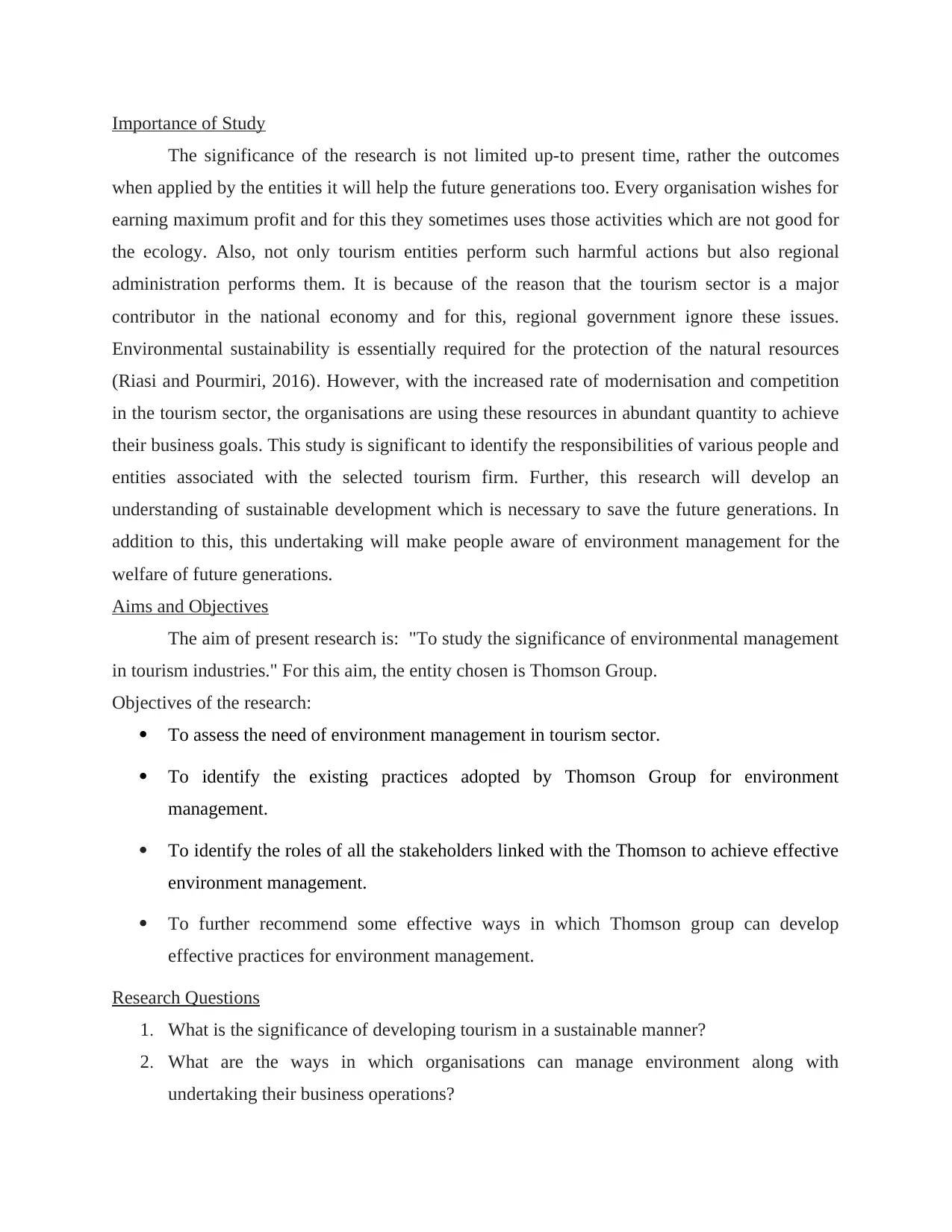
Importance of Study
The significance of the research is not limited up-to present time, rather the outcomes
when applied by the entities it will help the future generations too. Every organisation wishes for
earning maximum profit and for this they sometimes uses those activities which are not good for
the ecology. Also, not only tourism entities perform such harmful actions but also regional
administration performs them. It is because of the reason that the tourism sector is a major
contributor in the national economy and for this, regional government ignore these issues.
Environmental sustainability is essentially required for the protection of the natural resources
(Riasi and Pourmiri, 2016). However, with the increased rate of modernisation and competition
in the tourism sector, the organisations are using these resources in abundant quantity to achieve
their business goals. This study is significant to identify the responsibilities of various people and
entities associated with the selected tourism firm. Further, this research will develop an
understanding of sustainable development which is necessary to save the future generations. In
addition to this, this undertaking will make people aware of environment management for the
welfare of future generations.
Aims and Objectives
The aim of present research is: "To study the significance of environmental management
in tourism industries." For this aim, the entity chosen is Thomson Group.
Objectives of the research:
To assess the need of environment management in tourism sector.
To identify the existing practices adopted by Thomson Group for environment
management.
To identify the roles of all the stakeholders linked with the Thomson to achieve effective
environment management.
To further recommend some effective ways in which Thomson group can develop
effective practices for environment management.
Research Questions
1. What is the significance of developing tourism in a sustainable manner?
2. What are the ways in which organisations can manage environment along with
undertaking their business operations?
The significance of the research is not limited up-to present time, rather the outcomes
when applied by the entities it will help the future generations too. Every organisation wishes for
earning maximum profit and for this they sometimes uses those activities which are not good for
the ecology. Also, not only tourism entities perform such harmful actions but also regional
administration performs them. It is because of the reason that the tourism sector is a major
contributor in the national economy and for this, regional government ignore these issues.
Environmental sustainability is essentially required for the protection of the natural resources
(Riasi and Pourmiri, 2016). However, with the increased rate of modernisation and competition
in the tourism sector, the organisations are using these resources in abundant quantity to achieve
their business goals. This study is significant to identify the responsibilities of various people and
entities associated with the selected tourism firm. Further, this research will develop an
understanding of sustainable development which is necessary to save the future generations. In
addition to this, this undertaking will make people aware of environment management for the
welfare of future generations.
Aims and Objectives
The aim of present research is: "To study the significance of environmental management
in tourism industries." For this aim, the entity chosen is Thomson Group.
Objectives of the research:
To assess the need of environment management in tourism sector.
To identify the existing practices adopted by Thomson Group for environment
management.
To identify the roles of all the stakeholders linked with the Thomson to achieve effective
environment management.
To further recommend some effective ways in which Thomson group can develop
effective practices for environment management.
Research Questions
1. What is the significance of developing tourism in a sustainable manner?
2. What are the ways in which organisations can manage environment along with
undertaking their business operations?
Paraphrase This Document
Need a fresh take? Get an instant paraphrase of this document with our AI Paraphraser

3. How other people associated with the tourism sector can help in environment
management?
At the end of reading the present research thoroughly, the reader will be able to answer
all these questions.
Literature review
According to Bennett, (2016), despite of positive impacts of the tourism industries, they
also exerts an intense pressure on the environment of the existing destinations. The development
of these entities is good for economy of the nation, however it should be recognised that this
betterment is causing adverse impacts on the ecology. Development of hotels consumes the
hectares of forest with effective soil conditions leaving behind pollution due to decreased forest
size. In order to limit this, such firms should take effective steps. For instance: This
advancements will increase the population in the region that will cause air pollution. The demand
of basic resources such as water will raise, leaving major impacts behind. For this, hotels can
limit the use of water per guest. Also, heritage sites gets ruined by the careless practices of the
tourisms companies. In this way, it is highly demanded for the organisations belonging from this
sector to possess effective environment management strategies.
This type control includes various steps that can control the factors which harms the
surrounding by implementing effective strategies. This management will limit the emission of
harmful substances that can harm the ecological factors. They can preserve the heritage sites for
longer time so that future generations can also see them. Further, this will cover the actions like
waste water treatments, limitation in carbon emission, lower noises while operating equipments,
minimum use of resource, etc. This will help in reducing the extent of so many types of pollution
such as water, air, sound, etc. (Modica, and Uysal, 2016). Further, reuse and recycling are
effective method that brings so many benefits to the environment. In addition this, visitors also
gets attracted to the companies that run effective campaigns to save the environment. This makes
them feel that they too are contributing in the sustainable development. Hence, tourism
organisations are suggested to have suitable techniques to manage the environment.
As per the views of Kim, and Filimonau, (2017), tourism organisation should adopt some
effective practices that can save the environment. However, its should be recognised that there
are many techniques that are used by the selected organisation Thomson Group which are
implemented with a purpose to save environment. There are highly effective corporate social
management?
At the end of reading the present research thoroughly, the reader will be able to answer
all these questions.
Literature review
According to Bennett, (2016), despite of positive impacts of the tourism industries, they
also exerts an intense pressure on the environment of the existing destinations. The development
of these entities is good for economy of the nation, however it should be recognised that this
betterment is causing adverse impacts on the ecology. Development of hotels consumes the
hectares of forest with effective soil conditions leaving behind pollution due to decreased forest
size. In order to limit this, such firms should take effective steps. For instance: This
advancements will increase the population in the region that will cause air pollution. The demand
of basic resources such as water will raise, leaving major impacts behind. For this, hotels can
limit the use of water per guest. Also, heritage sites gets ruined by the careless practices of the
tourisms companies. In this way, it is highly demanded for the organisations belonging from this
sector to possess effective environment management strategies.
This type control includes various steps that can control the factors which harms the
surrounding by implementing effective strategies. This management will limit the emission of
harmful substances that can harm the ecological factors. They can preserve the heritage sites for
longer time so that future generations can also see them. Further, this will cover the actions like
waste water treatments, limitation in carbon emission, lower noises while operating equipments,
minimum use of resource, etc. This will help in reducing the extent of so many types of pollution
such as water, air, sound, etc. (Modica, and Uysal, 2016). Further, reuse and recycling are
effective method that brings so many benefits to the environment. In addition this, visitors also
gets attracted to the companies that run effective campaigns to save the environment. This makes
them feel that they too are contributing in the sustainable development. Hence, tourism
organisations are suggested to have suitable techniques to manage the environment.
As per the views of Kim, and Filimonau, (2017), tourism organisation should adopt some
effective practices that can save the environment. However, its should be recognised that there
are many techniques that are used by the selected organisation Thomson Group which are
implemented with a purpose to save environment. There are highly effective corporate social
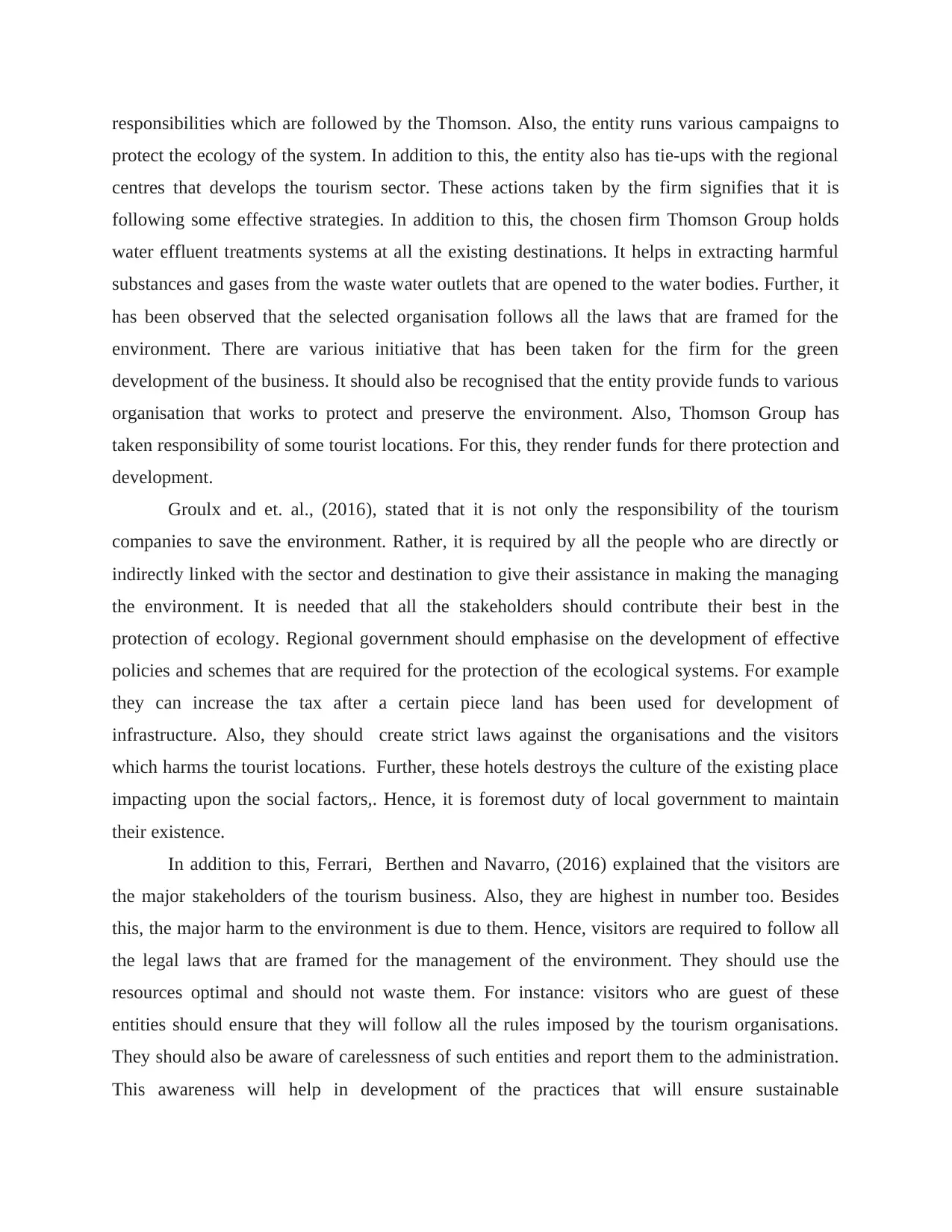
responsibilities which are followed by the Thomson. Also, the entity runs various campaigns to
protect the ecology of the system. In addition to this, the entity also has tie-ups with the regional
centres that develops the tourism sector. These actions taken by the firm signifies that it is
following some effective strategies. In addition to this, the chosen firm Thomson Group holds
water effluent treatments systems at all the existing destinations. It helps in extracting harmful
substances and gases from the waste water outlets that are opened to the water bodies. Further, it
has been observed that the selected organisation follows all the laws that are framed for the
environment. There are various initiative that has been taken for the firm for the green
development of the business. It should also be recognised that the entity provide funds to various
organisation that works to protect and preserve the environment. Also, Thomson Group has
taken responsibility of some tourist locations. For this, they render funds for there protection and
development.
Groulx and et. al., (2016), stated that it is not only the responsibility of the tourism
companies to save the environment. Rather, it is required by all the people who are directly or
indirectly linked with the sector and destination to give their assistance in making the managing
the environment. It is needed that all the stakeholders should contribute their best in the
protection of ecology. Regional government should emphasise on the development of effective
policies and schemes that are required for the protection of the ecological systems. For example
they can increase the tax after a certain piece land has been used for development of
infrastructure. Also, they should create strict laws against the organisations and the visitors
which harms the tourist locations. Further, these hotels destroys the culture of the existing place
impacting upon the social factors,. Hence, it is foremost duty of local government to maintain
their existence.
In addition to this, Ferrari, Berthen and Navarro, (2016) explained that the visitors are
the major stakeholders of the tourism business. Also, they are highest in number too. Besides
this, the major harm to the environment is due to them. Hence, visitors are required to follow all
the legal laws that are framed for the management of the environment. They should use the
resources optimal and should not waste them. For instance: visitors who are guest of these
entities should ensure that they will follow all the rules imposed by the tourism organisations.
They should also be aware of carelessness of such entities and report them to the administration.
This awareness will help in development of the practices that will ensure sustainable
protect the ecology of the system. In addition to this, the entity also has tie-ups with the regional
centres that develops the tourism sector. These actions taken by the firm signifies that it is
following some effective strategies. In addition to this, the chosen firm Thomson Group holds
water effluent treatments systems at all the existing destinations. It helps in extracting harmful
substances and gases from the waste water outlets that are opened to the water bodies. Further, it
has been observed that the selected organisation follows all the laws that are framed for the
environment. There are various initiative that has been taken for the firm for the green
development of the business. It should also be recognised that the entity provide funds to various
organisation that works to protect and preserve the environment. Also, Thomson Group has
taken responsibility of some tourist locations. For this, they render funds for there protection and
development.
Groulx and et. al., (2016), stated that it is not only the responsibility of the tourism
companies to save the environment. Rather, it is required by all the people who are directly or
indirectly linked with the sector and destination to give their assistance in making the managing
the environment. It is needed that all the stakeholders should contribute their best in the
protection of ecology. Regional government should emphasise on the development of effective
policies and schemes that are required for the protection of the ecological systems. For example
they can increase the tax after a certain piece land has been used for development of
infrastructure. Also, they should create strict laws against the organisations and the visitors
which harms the tourist locations. Further, these hotels destroys the culture of the existing place
impacting upon the social factors,. Hence, it is foremost duty of local government to maintain
their existence.
In addition to this, Ferrari, Berthen and Navarro, (2016) explained that the visitors are
the major stakeholders of the tourism business. Also, they are highest in number too. Besides
this, the major harm to the environment is due to them. Hence, visitors are required to follow all
the legal laws that are framed for the management of the environment. They should use the
resources optimal and should not waste them. For instance: visitors who are guest of these
entities should ensure that they will follow all the rules imposed by the tourism organisations.
They should also be aware of carelessness of such entities and report them to the administration.
This awareness will help in development of the practices that will ensure sustainable
⊘ This is a preview!⊘
Do you want full access?
Subscribe today to unlock all pages.

Trusted by 1+ million students worldwide
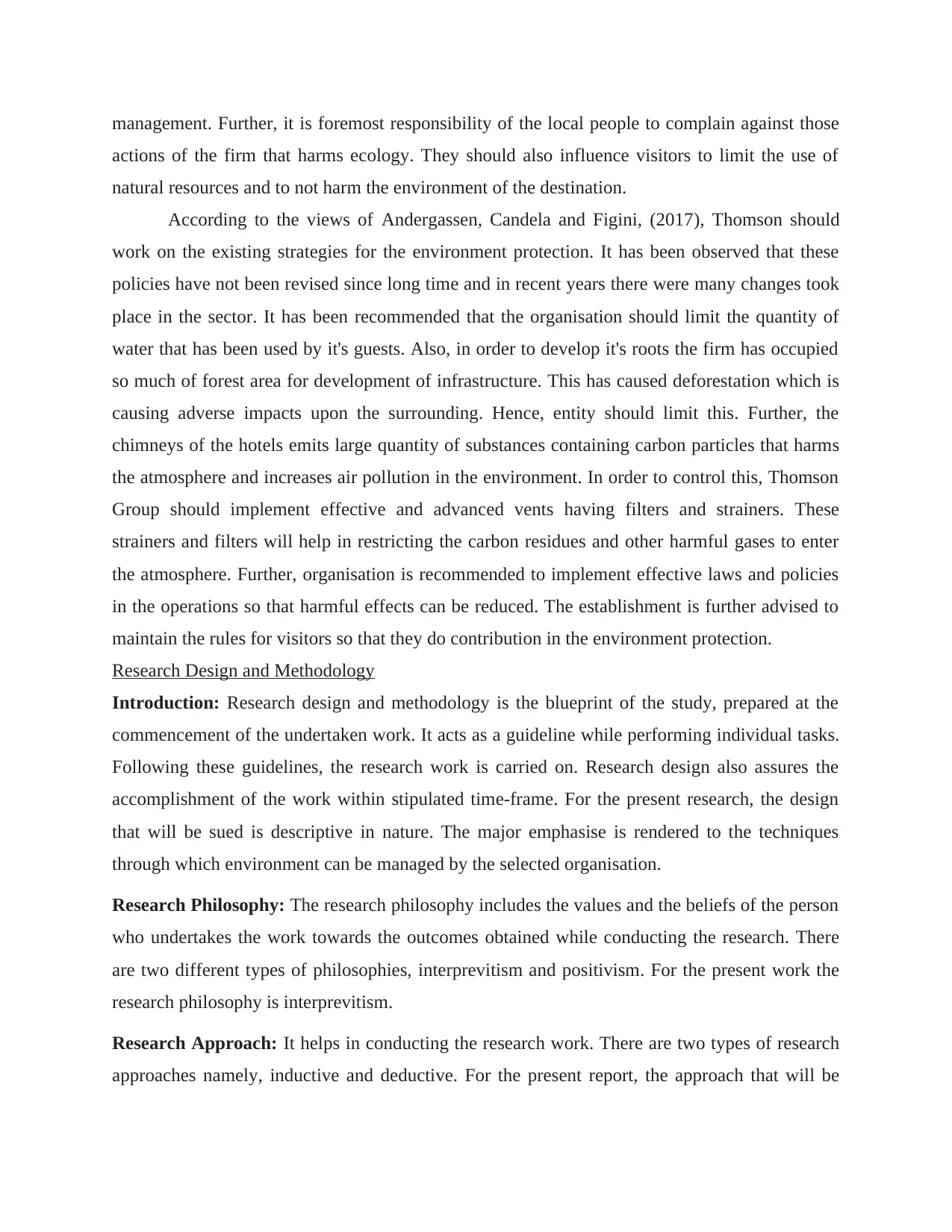
management. Further, it is foremost responsibility of the local people to complain against those
actions of the firm that harms ecology. They should also influence visitors to limit the use of
natural resources and to not harm the environment of the destination.
According to the views of Andergassen, Candela and Figini, (2017), Thomson should
work on the existing strategies for the environment protection. It has been observed that these
policies have not been revised since long time and in recent years there were many changes took
place in the sector. It has been recommended that the organisation should limit the quantity of
water that has been used by it's guests. Also, in order to develop it's roots the firm has occupied
so much of forest area for development of infrastructure. This has caused deforestation which is
causing adverse impacts upon the surrounding. Hence, entity should limit this. Further, the
chimneys of the hotels emits large quantity of substances containing carbon particles that harms
the atmosphere and increases air pollution in the environment. In order to control this, Thomson
Group should implement effective and advanced vents having filters and strainers. These
strainers and filters will help in restricting the carbon residues and other harmful gases to enter
the atmosphere. Further, organisation is recommended to implement effective laws and policies
in the operations so that harmful effects can be reduced. The establishment is further advised to
maintain the rules for visitors so that they do contribution in the environment protection.
Research Design and Methodology
Introduction: Research design and methodology is the blueprint of the study, prepared at the
commencement of the undertaken work. It acts as a guideline while performing individual tasks.
Following these guidelines, the research work is carried on. Research design also assures the
accomplishment of the work within stipulated time-frame. For the present research, the design
that will be sued is descriptive in nature. The major emphasise is rendered to the techniques
through which environment can be managed by the selected organisation.
Research Philosophy: The research philosophy includes the values and the beliefs of the person
who undertakes the work towards the outcomes obtained while conducting the research. There
are two different types of philosophies, interprevitism and positivism. For the present work the
research philosophy is interprevitism.
Research Approach: It helps in conducting the research work. There are two types of research
approaches namely, inductive and deductive. For the present report, the approach that will be
actions of the firm that harms ecology. They should also influence visitors to limit the use of
natural resources and to not harm the environment of the destination.
According to the views of Andergassen, Candela and Figini, (2017), Thomson should
work on the existing strategies for the environment protection. It has been observed that these
policies have not been revised since long time and in recent years there were many changes took
place in the sector. It has been recommended that the organisation should limit the quantity of
water that has been used by it's guests. Also, in order to develop it's roots the firm has occupied
so much of forest area for development of infrastructure. This has caused deforestation which is
causing adverse impacts upon the surrounding. Hence, entity should limit this. Further, the
chimneys of the hotels emits large quantity of substances containing carbon particles that harms
the atmosphere and increases air pollution in the environment. In order to control this, Thomson
Group should implement effective and advanced vents having filters and strainers. These
strainers and filters will help in restricting the carbon residues and other harmful gases to enter
the atmosphere. Further, organisation is recommended to implement effective laws and policies
in the operations so that harmful effects can be reduced. The establishment is further advised to
maintain the rules for visitors so that they do contribution in the environment protection.
Research Design and Methodology
Introduction: Research design and methodology is the blueprint of the study, prepared at the
commencement of the undertaken work. It acts as a guideline while performing individual tasks.
Following these guidelines, the research work is carried on. Research design also assures the
accomplishment of the work within stipulated time-frame. For the present research, the design
that will be sued is descriptive in nature. The major emphasise is rendered to the techniques
through which environment can be managed by the selected organisation.
Research Philosophy: The research philosophy includes the values and the beliefs of the person
who undertakes the work towards the outcomes obtained while conducting the research. There
are two different types of philosophies, interprevitism and positivism. For the present work the
research philosophy is interprevitism.
Research Approach: It helps in conducting the research work. There are two types of research
approaches namely, inductive and deductive. For the present report, the approach that will be
Paraphrase This Document
Need a fresh take? Get an instant paraphrase of this document with our AI Paraphraser
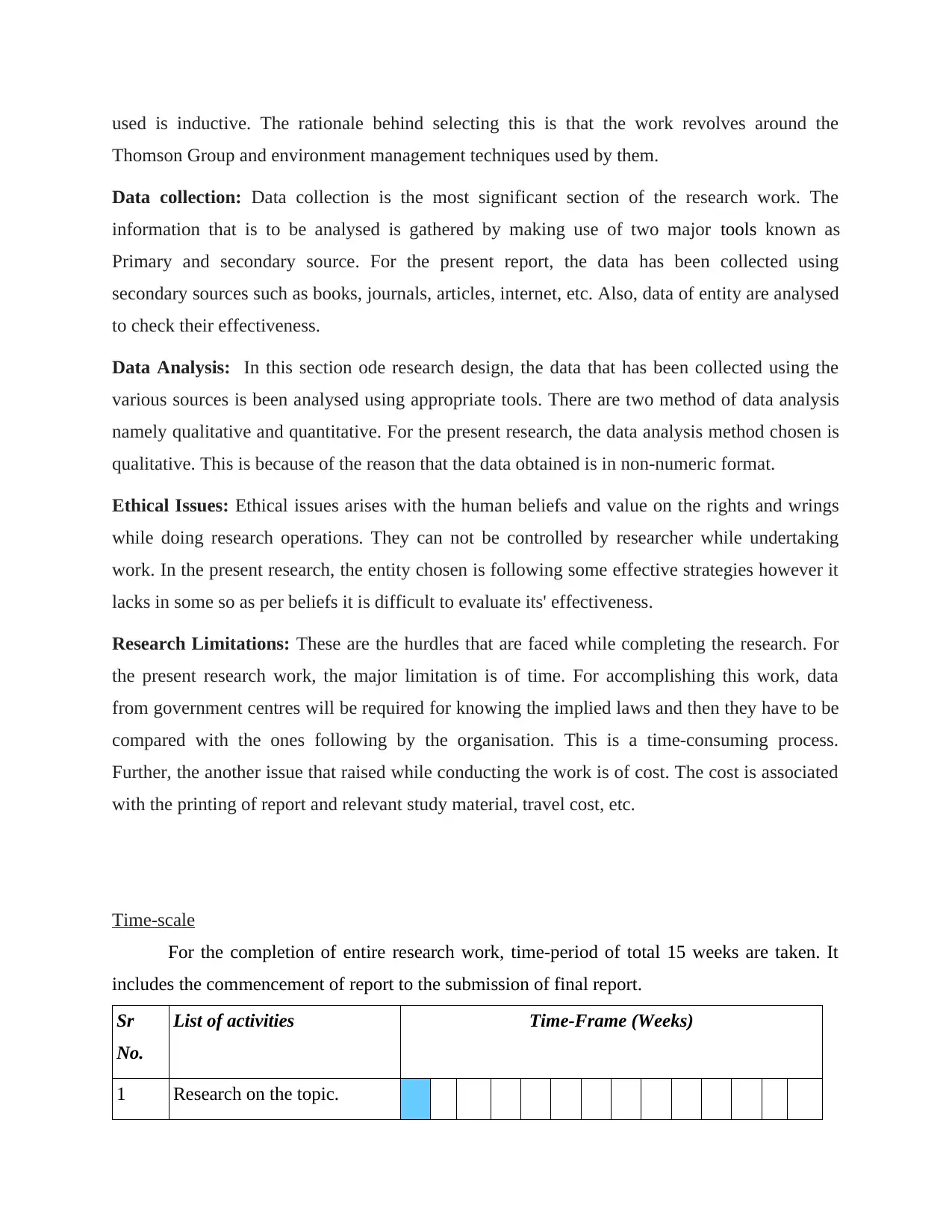
used is inductive. The rationale behind selecting this is that the work revolves around the
Thomson Group and environment management techniques used by them.
Data collection: Data collection is the most significant section of the research work. The
information that is to be analysed is gathered by making use of two major tools known as
Primary and secondary source. For the present report, the data has been collected using
secondary sources such as books, journals, articles, internet, etc. Also, data of entity are analysed
to check their effectiveness.
Data Analysis: In this section ode research design, the data that has been collected using the
various sources is been analysed using appropriate tools. There are two method of data analysis
namely qualitative and quantitative. For the present research, the data analysis method chosen is
qualitative. This is because of the reason that the data obtained is in non-numeric format.
Ethical Issues: Ethical issues arises with the human beliefs and value on the rights and wrings
while doing research operations. They can not be controlled by researcher while undertaking
work. In the present research, the entity chosen is following some effective strategies however it
lacks in some so as per beliefs it is difficult to evaluate its' effectiveness.
Research Limitations: These are the hurdles that are faced while completing the research. For
the present research work, the major limitation is of time. For accomplishing this work, data
from government centres will be required for knowing the implied laws and then they have to be
compared with the ones following by the organisation. This is a time-consuming process.
Further, the another issue that raised while conducting the work is of cost. The cost is associated
with the printing of report and relevant study material, travel cost, etc.
Time-scale
For the completion of entire research work, time-period of total 15 weeks are taken. It
includes the commencement of report to the submission of final report.
Sr
No.
List of activities Time-Frame (Weeks)
1 Research on the topic.
Thomson Group and environment management techniques used by them.
Data collection: Data collection is the most significant section of the research work. The
information that is to be analysed is gathered by making use of two major tools known as
Primary and secondary source. For the present report, the data has been collected using
secondary sources such as books, journals, articles, internet, etc. Also, data of entity are analysed
to check their effectiveness.
Data Analysis: In this section ode research design, the data that has been collected using the
various sources is been analysed using appropriate tools. There are two method of data analysis
namely qualitative and quantitative. For the present research, the data analysis method chosen is
qualitative. This is because of the reason that the data obtained is in non-numeric format.
Ethical Issues: Ethical issues arises with the human beliefs and value on the rights and wrings
while doing research operations. They can not be controlled by researcher while undertaking
work. In the present research, the entity chosen is following some effective strategies however it
lacks in some so as per beliefs it is difficult to evaluate its' effectiveness.
Research Limitations: These are the hurdles that are faced while completing the research. For
the present research work, the major limitation is of time. For accomplishing this work, data
from government centres will be required for knowing the implied laws and then they have to be
compared with the ones following by the organisation. This is a time-consuming process.
Further, the another issue that raised while conducting the work is of cost. The cost is associated
with the printing of report and relevant study material, travel cost, etc.
Time-scale
For the completion of entire research work, time-period of total 15 weeks are taken. It
includes the commencement of report to the submission of final report.
Sr
No.
List of activities Time-Frame (Weeks)
1 Research on the topic.
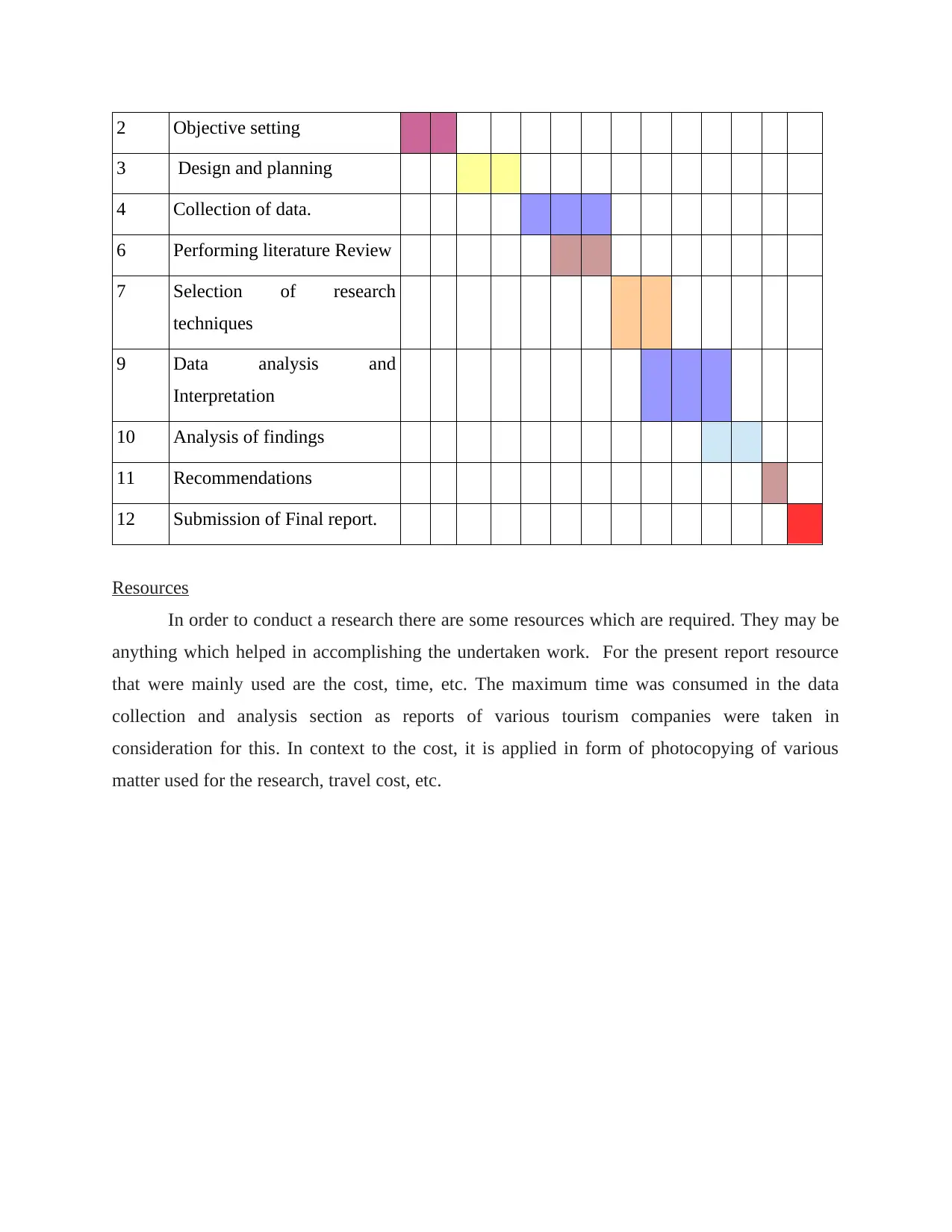
2 Objective setting
3 Design and planning
4 Collection of data.
6 Performing literature Review
7 Selection of research
techniques
9 Data analysis and
Interpretation
10 Analysis of findings
11 Recommendations
12 Submission of Final report.
Resources
In order to conduct a research there are some resources which are required. They may be
anything which helped in accomplishing the undertaken work. For the present report resource
that were mainly used are the cost, time, etc. The maximum time was consumed in the data
collection and analysis section as reports of various tourism companies were taken in
consideration for this. In context to the cost, it is applied in form of photocopying of various
matter used for the research, travel cost, etc.
3 Design and planning
4 Collection of data.
6 Performing literature Review
7 Selection of research
techniques
9 Data analysis and
Interpretation
10 Analysis of findings
11 Recommendations
12 Submission of Final report.
Resources
In order to conduct a research there are some resources which are required. They may be
anything which helped in accomplishing the undertaken work. For the present report resource
that were mainly used are the cost, time, etc. The maximum time was consumed in the data
collection and analysis section as reports of various tourism companies were taken in
consideration for this. In context to the cost, it is applied in form of photocopying of various
matter used for the research, travel cost, etc.
⊘ This is a preview!⊘
Do you want full access?
Subscribe today to unlock all pages.

Trusted by 1+ million students worldwide
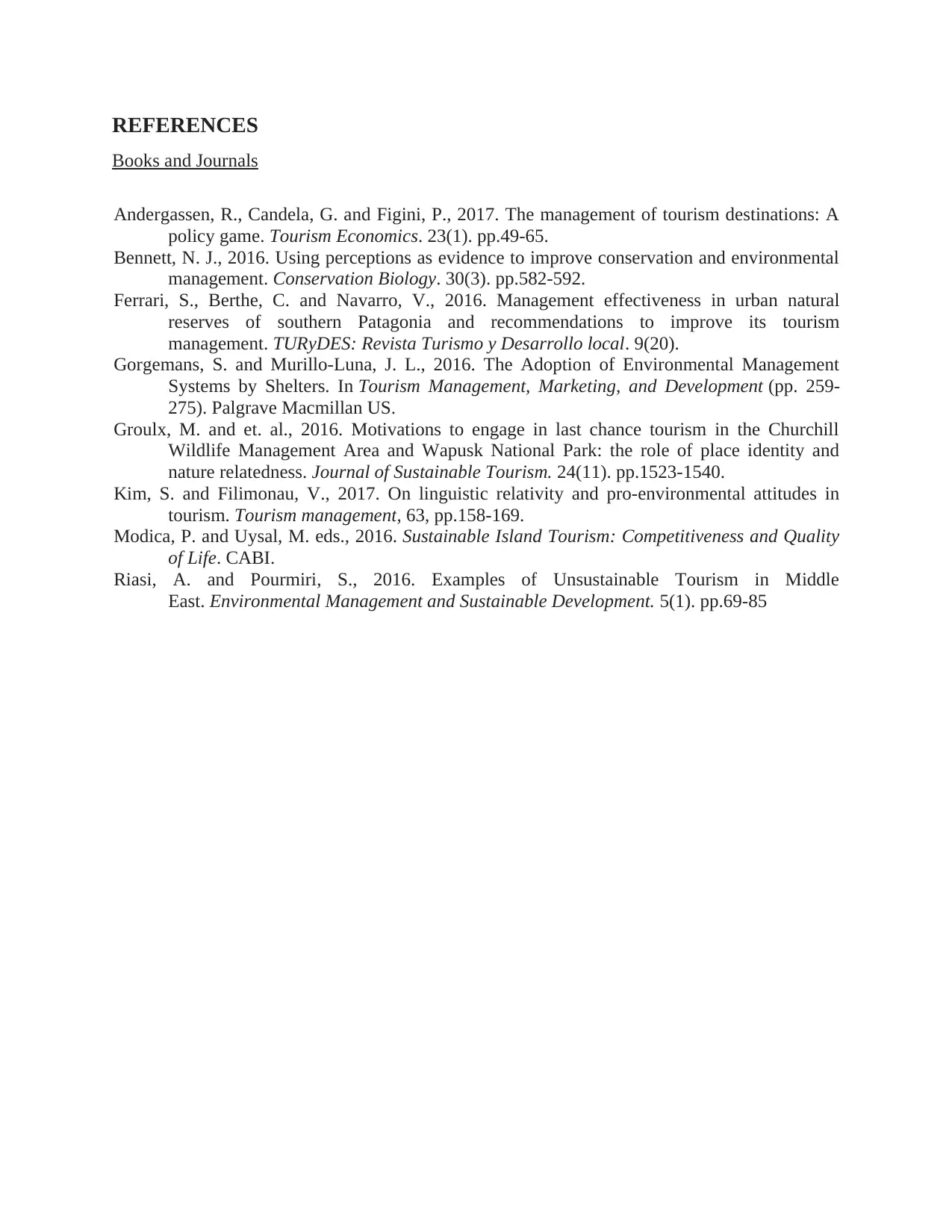
REFERENCES
Books and Journals
Andergassen, R., Candela, G. and Figini, P., 2017. The management of tourism destinations: A
policy game. Tourism Economics. 23(1). pp.49-65.
Bennett, N. J., 2016. Using perceptions as evidence to improve conservation and environmental
management. Conservation Biology. 30(3). pp.582-592.
Ferrari, S., Berthe, C. and Navarro, V., 2016. Management effectiveness in urban natural
reserves of southern Patagonia and recommendations to improve its tourism
management. TURyDES: Revista Turismo y Desarrollo local. 9(20).
Gorgemans, S. and Murillo-Luna, J. L., 2016. The Adoption of Environmental Management
Systems by Shelters. In Tourism Management, Marketing, and Development (pp. 259-
275). Palgrave Macmillan US.
Groulx, M. and et. al., 2016. Motivations to engage in last chance tourism in the Churchill
Wildlife Management Area and Wapusk National Park: the role of place identity and
nature relatedness. Journal of Sustainable Tourism. 24(11). pp.1523-1540.
Kim, S. and Filimonau, V., 2017. On linguistic relativity and pro-environmental attitudes in
tourism. Tourism management, 63, pp.158-169.
Modica, P. and Uysal, M. eds., 2016. Sustainable Island Tourism: Competitiveness and Quality
of Life. CABI.
Riasi, A. and Pourmiri, S., 2016. Examples of Unsustainable Tourism in Middle
East. Environmental Management and Sustainable Development. 5(1). pp.69-85
Books and Journals
Andergassen, R., Candela, G. and Figini, P., 2017. The management of tourism destinations: A
policy game. Tourism Economics. 23(1). pp.49-65.
Bennett, N. J., 2016. Using perceptions as evidence to improve conservation and environmental
management. Conservation Biology. 30(3). pp.582-592.
Ferrari, S., Berthe, C. and Navarro, V., 2016. Management effectiveness in urban natural
reserves of southern Patagonia and recommendations to improve its tourism
management. TURyDES: Revista Turismo y Desarrollo local. 9(20).
Gorgemans, S. and Murillo-Luna, J. L., 2016. The Adoption of Environmental Management
Systems by Shelters. In Tourism Management, Marketing, and Development (pp. 259-
275). Palgrave Macmillan US.
Groulx, M. and et. al., 2016. Motivations to engage in last chance tourism in the Churchill
Wildlife Management Area and Wapusk National Park: the role of place identity and
nature relatedness. Journal of Sustainable Tourism. 24(11). pp.1523-1540.
Kim, S. and Filimonau, V., 2017. On linguistic relativity and pro-environmental attitudes in
tourism. Tourism management, 63, pp.158-169.
Modica, P. and Uysal, M. eds., 2016. Sustainable Island Tourism: Competitiveness and Quality
of Life. CABI.
Riasi, A. and Pourmiri, S., 2016. Examples of Unsustainable Tourism in Middle
East. Environmental Management and Sustainable Development. 5(1). pp.69-85
1 out of 10
Related Documents
Your All-in-One AI-Powered Toolkit for Academic Success.
+13062052269
info@desklib.com
Available 24*7 on WhatsApp / Email
![[object Object]](/_next/static/media/star-bottom.7253800d.svg)
Unlock your academic potential
Copyright © 2020–2025 A2Z Services. All Rights Reserved. Developed and managed by ZUCOL.




